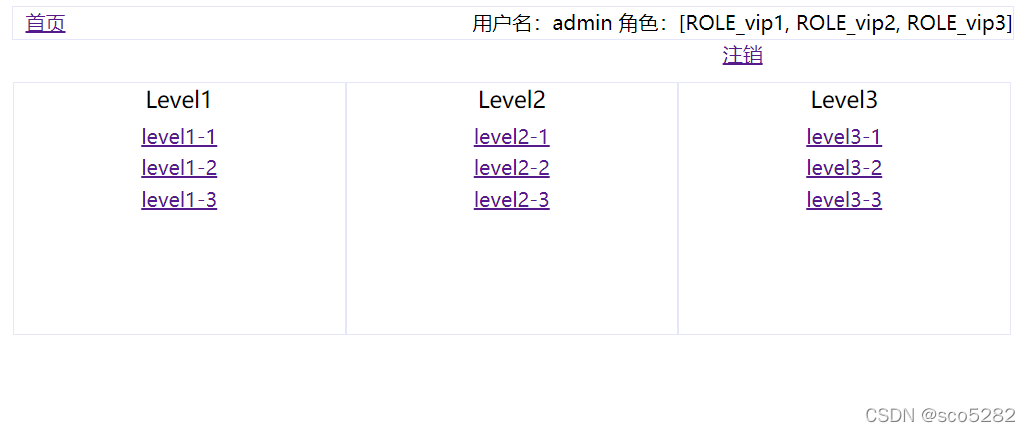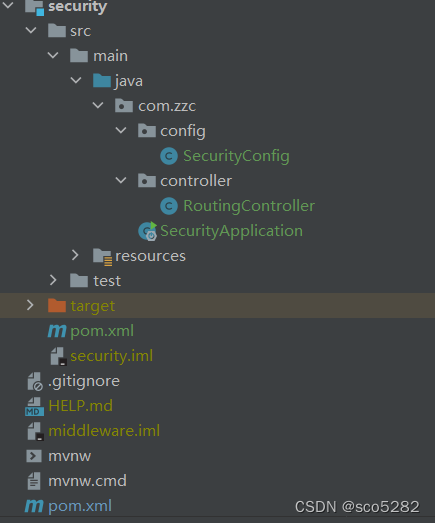在 SpringBoot 工程中,借用 SpringSecurity 权限框架来对登录用户所拥有的不同的权限来显示不同的页面。并且,如果有用户已登录,则右上角显示用户名和其角色。如下图:
admin 用户权限最大,显示所有页面内容:

zzc 用户只有两个角色权限,所以,只显示部分内容:

没有用户登录时,页面显示如下:

【首页】、【登录】下方的内容都没有显示。
好了,需求已经了解清楚了,那咱们就直接上代码了哈。【文末有源码】
【开发环境】:
- IDEA-2020.2
- SpringBoot-2.5.5
- MAVEN-3.5.3
- SpringSecurity
- Thymeleaf
项目结构图
后台:

前台:

1、引入依赖:
<dependency>
<groupId>org.springframework.boot</groupId>
<artifactId>spring-boot-starter-web</artifactId>
</dependency>
<!-- springsecurity -->
<dependency>
<groupId>org.springframework.boot</groupId>
<artifactId>spring-boot-starter-security</artifactId>
</dependency>
<!-- thymeleaf -->
<dependency>
<groupId>org.springframework.boot</groupId>
<artifactId>spring-boot-starter-thymeleaf</artifactId>
</dependency>
<!-- thymeleaf-springsecurity -->
<dependency>
<groupId>org.thymeleaf.extras</groupId>
<artifactId>thymeleaf-extras-springsecurity5</artifactId>
</dependency>
2、添加
application.yml
配置:
spring:
thymeleaf:
cache: false
prefix: classpath:/templates/ # 配置模板(非必要) 默认是 templates
suffix: .html
3、后台路由控制器
RoutingController
@Controller
public class RoutingController {
@GetMapping({"/", "/index"})
public String index() {
return "index";
}
@GetMapping("/toLogin")
public String toLogin() {
return "views/login";
}
@GetMapping("/level1/{id}")
public String level1(@PathVariable("id") int id) {
return "views/level1/" + id;
}
@GetMapping("/level2/{id}")
public String level2(@PathVariable("id") int id) {
return "views/level2/" + id;
}
@GetMapping("/level3/{id}")
public String level3(@PathVariable("id") int id) {
return "views/level3/" + id;
}
}
4、SpringSecurity 配置类
SecurityConfig
使用 SpringSecurity 需要添加一个配置类:
@EnableWebSecurity
public class SecurityConfig extends WebSecurityConfigurerAdapter {
// 授权
@Override
protected void configure(HttpSecurity http) throws Exception {
// 1.配置请求授权规则
// 首页所有人可以访问;其它页面需要相应的角色权限才能访问
http.authorizeRequests()
.antMatchers("/").permitAll()
.antMatchers("/level1/**").hasRole("vip1")
.antMatchers("/level2/**").hasRole("vip2")
.antMatchers("/level3/**").hasRole("vip3");
// 2.没有权限,默认会跳转到登录页面,需要开启登录页面
http.formLogin()
// 自定义登录页面
.loginPage("/toLogin").usernameParameter("name").passwordParameter("pwd").loginProcessingUrl("/login");
// 关闭csrf
http.csrf().disable();
// 3.注销,跳转到首页
http.logout().logoutSuccessUrl("/");
}
// 认证
@Override
protected void configure(AuthenticationManagerBuilder auth) throws Exception {
// inMemoryAuthentication:从内存中认证;jdbcAuthentication:从数据库中认证
// BCryptPasswordEncoder:密码编码规则,如果没有设置,则登录时会报错
auth.inMemoryAuthentication().passwordEncoder(new BCryptPasswordEncoder())
.withUser("zzc").password(new BCryptPasswordEncoder().encode("66666")).roles("vip1", "vip3")
.and()
.withUser("admin").password(new BCryptPasswordEncoder().encode("admin")).roles("vip1", "vip2", "vip3");
}
}
- configure(HttpSecurity http):配置了访问哪些 url,需要相对应的角色
- configure(AuthenticationManagerBuilder auth):配置了哪些用户有哪些角色
5、前台首页
index.html
<!DOCTYPE html>
<html lang="en" xmlns:th="http://www.thymeleaf.org"
xmlns:sec="http://www.thymeleaf.org/thymeleaf-extras-springsecurity5">
<head>
<meta charset="UTF-8">
<title>首页</title>
<link rel="stylesheet" th:href="@{/css/index.css}" />
</head>
<body>
<div id="container">
<div id="nav" class="clearfloat">
<div class="nav" id="first_page"><a th:href="@{/index}">首页</a></div>
<div class="nav" id="logout" sec:authorize="isAuthenticated()">
<div>
用户名:<span sec:authentication="name"></span>
角色:<span sec:authentication="principal.authorities"></span>
</div>
<a th:href="@{/logout}">注销</a>
</div>
<div class="nav" id="login" sec:authorize="!isAuthenticated()">
<a th:href="@{/toLogin}">登录</a>
</div>
</div>
<div id="middle"></div>
<div id="bottom">
<div class="box" sec:authorize="hasRole('vip1')">
<div>Level1</div>
<a href="/level1/1">level1-1</a>
<a href="/level1/2">level1-2</a>
<a href="/level1/3">level1-3</a>
</div>
<div class="box" sec:authorize="hasRole('vip2')">
<div>Level2</div>
<a href="/level2/1">level2-1</a>
<a href="/level2/2">level2-2</a>
<a href="/level2/3">level2-3</a>
</div>
<div class="box" sec:authorize="hasRole('vip3')">
<div>Level3</div>
<a href="/level3/1">level3-1</a>
<a href="/level3/2">level3-2</a>
<a href="/level3/3">level3-3</a>
</div>
</div>
</div>
</body>
</html>
这段代码:
<div class="nav" id="logout" sec:authorize="isAuthenticated()">
<div>
用户名:<span sec:authentication="name"></span>
角色:<span sec:authentication="principal.authorities"></span>
</div>
<a th:href="@{/logout}">注销</a>
</div>
当用户登录后,就显示用户名和角色
这段代码:
<div class="box" sec:authorize="hasRole('vip1')">
<div>Level1</div>
<a href="/level1/1">level1-1</a>
<a href="/level1/2">level1-2</a>
<a href="/level1/3">level1-3</a>
</div>
只有角色是
vip1
的时候,才显示其内容
6、登录页面
login.html
<!DOCTYPE html>
<html lang="en" xmlns:th="http://www.thymeleaf.org">
<head>
<meta charset="UTF-8">
<title>Title</title>
</head>
<body>
<h1>登录页面</h1>
<form method="post" th:action="@{/login}">
用户名:<input type="text" name="name" /><br>
密码:<input type="password" name="pwd" /><br>
<input type="submit" value="登录" />
</form>
</body>
</html>
【注意】:这里的登录后台接口是
/login
,但是,在我们自己的后台接口中是没有这个接口的,它是通过 SpringSecurity 进行处理的。
所以,我们
SecurityConfig#configure(HttpSecurity http)
方法中有如下代码:
http.formLogin()
// 自定义登录页面
.loginPage("/toLogin").usernameParameter("name").passwordParameter("pwd").loginProcessingUrl("/login");
7、页面内容
1.html
level1/level2/level3 文件夹下的 html 文件内容基本一致,如下:
<!DOCTYPE html>
<html lang="en">
<head>
<meta charset="UTF-8">
<title>Title</title>
</head>
<body>
<h1>level1-1</h1>
</body>
</html>
这里就不重复粘贴了哈。